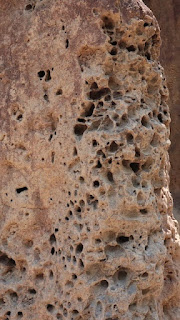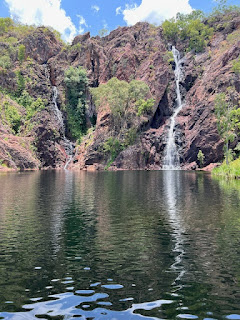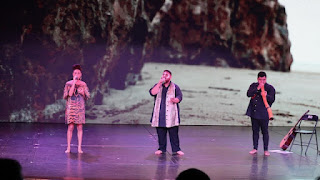Day 41: 20231103 Friday, November 3 2023- Darwin
Our sail into Darwin was pretty uneventful, unlike when we sailed into Tahiti or American Samoa where those islands arise out of nowhere. Darwin’s port area isn’t as large, or industrial as Brisbane’s.
The Cruise ship terminal is immediately adjacent to some modern mixed retail/residential condominium complexes associated with some very nice public water facilities.
We learned in Brisbane that salt water crocodiles and “stingers” (various poisonous jelly fishes, some of which are potentially lethal) make swimming in salt water not something to take for granted. There is a large sea wall separating the sea from a large lagoon which is regulated with sea gates. I didn’t see the intake for the lagoon specifically but did see a drain which was grated, but wonder if they have stinger nets to keep jelly fish out of the lagoon. There is a huge floating play area and people were swimming and playing in the water without a care. There is also a convention center and a large wave pool, although the wave pool was closed for renovation. The condos have restaurants and shops around the base which reminded me of the Historic waterfront of Buenos Aires which is similarly lined with mixed residential and commercial buildings.
Our Darwin excursion was a bus tour out to the Litchfield National Park, which is about 2hrs south of the cruise ship port. We drove through the city and into the countryside. There is a lot of WWII history in Darwin. It had been under attack by the Japanese for quite some time, especially after the surrender of Singapore. This gave the Japanese a base of operations within striking range of Australia, which was supplying troops and materiel for the allied forces. There are barracks and concrete oil tanks that still have Japanese machine gun bullet holes throughout the Darwin area as historical reminders. There is also a network of tunnels built into hillsides after the first wave of Japanese attacks. The highway leading out of Darwin to the Litchfield National Park literally doubled as runways for military aircraft operations throughout the war.
Darwin is between their “Dry” and “Wet” seasons. Usually, monsoon rains begin in November/December, ending the long dry season. The Darwin residents welcome the rains with rain parades and festivals. Parts of the region are subject to flooding during the wet season, but people have adapted. It was very warm- mid to upper 90’s into the low 100’s while we were there, with humidity around 80%. It literally felt like we stepped into a sauna the moment we stepped off the ship. We really appreciate the modern convenience of tour buses with air conditioning.
The countryside around Darwin is fairly flat with large stretches of Mango tree groves once you get outside of the city limits. There is a large military base outside Darwin that hosts a large contingent of US Marines and their Osprey tilt rotor aircraft. Our guides said the American Marines generally keep to themselves and don’t cause much ruckus in Darwin.
There are 3 main attractions in Litchfield National Park. One is the presence of large termite mounds. There are two main species of termites in this part. One is called the Magnetic Termites, not because they stick to a magnet, but because they align their mounds along a precise North-South axis. These mounds are 2m tall. The other main species are grass termites, which feed on grass, and build very large mounds up to 6m tall. These mounds can be shaped like Buddha hands sticking out of the earth. These mounds are created with clay, saliva and ant poo. They are as hard as brick in some cases. These are impressive structures. We were eager to get out of the buses to see these after the nearly 2 hour drive, but the heat and humidity drove us back into the buses within 15-20 minutes.
The other attraction in Litchfield National Park are numerous waterfalls. Some have plunge pools that are suitable swimming holes, provided they have been cleared of salt water crocodiles. The crocodiles have a hard time getting into these pools because of the elevations and the fact that crocodiles don’t like to climb over rocks, but during the wet seasons, flooding makes these more accessible to crocodiles, so most of the pools are closed to swimming because of both the crocodiles and dangerous flow volumes. We visited two waterfalls. The Wangi falls were pretty easy to access and lots of locals swam in the pool at the base. Our excursion description made no mention of swimming opportunities, although one or two people did bring swim suits and towels on the bus. We found a large colony of flying foxes, or fruit bats, fanning themselves in the woods adjacent to the waterfalls.
We had an outdoor lunch under a large tin roof with salad and grilled chicken. Our guide took orders for chicken and fish at the start of our tour, but when we arrived at the venue, there was only chicken. But the chicken was good and plentiful. Our bus provided ice cold water bottles which were greatly appreciated.
Our last stop was Tolmer Falls, which was an overlook on a very remote appearing fall on some very steep cliffs that were reminiscent of the falls in the Blue Mountains National Park. It was a little longer walk to the lookout, but there were no stairs to have to negotiate like in the Blue Mountains.
The drive back was a welcome opportunity to cool off and nap a bit. After getting dropped off at the cruise ship, we made our way to the Princess Theater for a cultural presentation by a local group. There were 3 young musicians- a male and female vocalists, and a male digerido player, who did several songs with music video backdrops that were all original compositions by the group. The vocals and instrumentals were beautiful, but most of the songs had underlying political tones that may have put off some of the audience, with themes of equality, justice and the need for respect of the sovereignty of the aboriginal tribes. There were two dance numbers with a small troupe of aboriginal dancers, but these appeared to be spontaneously choregraphed like some of our Native American “dances”, and nothing like the dance programs put on by the various Polynesian cultural groups that came aboard the Grand Princess during her cross Pacific crossing. Janet was annoyed because the show started late and she had to wait a half hour packed in a crowd outside the theater until they eventually opened the doors. They apparently were having technical difficulties getting everything synchronized and set up for the show.
We had dinner in the Provence dining room late because of the cultural show. We were so tired, that we retired directly after dinner. Our clocks bo back another half hour tonight.


















